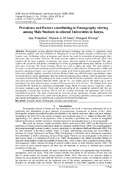| dc.contributor.author | Wamathai, Ann | |
| dc.contributor.author | Sirera, Merecia A. M | |
| dc.contributor.author | Mwenje, Margaret | |
| dc.date.accessioned | 2018-09-05T11:58:59Z | |
| dc.date.available | 2018-09-05T11:58:59Z | |
| dc.date.issued | 2014-11 | |
| dc.identifier.citation | IOSR Journal Of Humanities And Social Science (IOSR-JHSS) Volume 19, Issue 11, Ver. VI (Nov. 2014), PP 01-07 | en_US |
| dc.identifier.issn | 2279-0837 | |
| dc.identifier.issn | 2279-0845 | |
| dc.identifier.uri | https://karuspace.karu.ac.ke/handle/20.500.12092/2139 | |
| dc.description.abstract | Pornography viewing afforded through advanced technology has become a widespread social phenomenon globally and has contributed to changing the terrain of human sexuality in both positive and negative ways. Technology in form of computers and internet has made the availability of pornography faster and easier than ever before. However, the media provides unfiltered sexual explicit materials which when coupled with the loose regulatory mechanisms may expose university students to pornography. This paper explores the prevalence and factors contributing to viewing of pornography among male students in selected universities in Kenya. The Social Learning Theory was used to inform this study. The study adopted a descriptive research design employing a mixed method approach in data collection. Proportionate, random and purposive sampling techniques were used to select a sample of 487students from public (270) and private (217) universities and four students’ counselor in Kenya. Research data was collected using a questionnaire and a structured interview guide. Quantitative data was analyzed using descriptive statistic, while the qualitative data was analyzed thematically. The findings of the study revealed that 93% of the respondents had been exposed to some forms of Sexually Explicit Materials (SEM) and 16.7 % were highly exposed. The highest age in which participants were first exposed to porn viewing at 62% was between 13 to 18 years. The findings of the study revealed that the students are exposed to pornographic images found in various sources; magazines, videos, televisions, computers and internet. Forty eight percent (48%) of the respondents indicated that they use pornography to satisfy their curiosity, 43% to seek for sexuality knowledge and information and 43% for entertainment purposes. The study recommends for provision of age appropriate sexuality information and education at all educational levels, public and media forums. Strong policy guidelines and programs to control and regulate pornography use should be put in place for the betterment of humanity | en_US |
| dc.language.iso | en | en_US |
| dc.subject | Sexuality | en_US |
| dc.subject | Media | en_US |
| dc.subject | Pornography | en_US |
| dc.subject | Sexually explicit materials | en_US |
| dc.title | Prevalence and Factors contributing to Pornography viewing among Male Students in selected Universities in Kenya | en_US |
| dc.type | Article | en_US |
